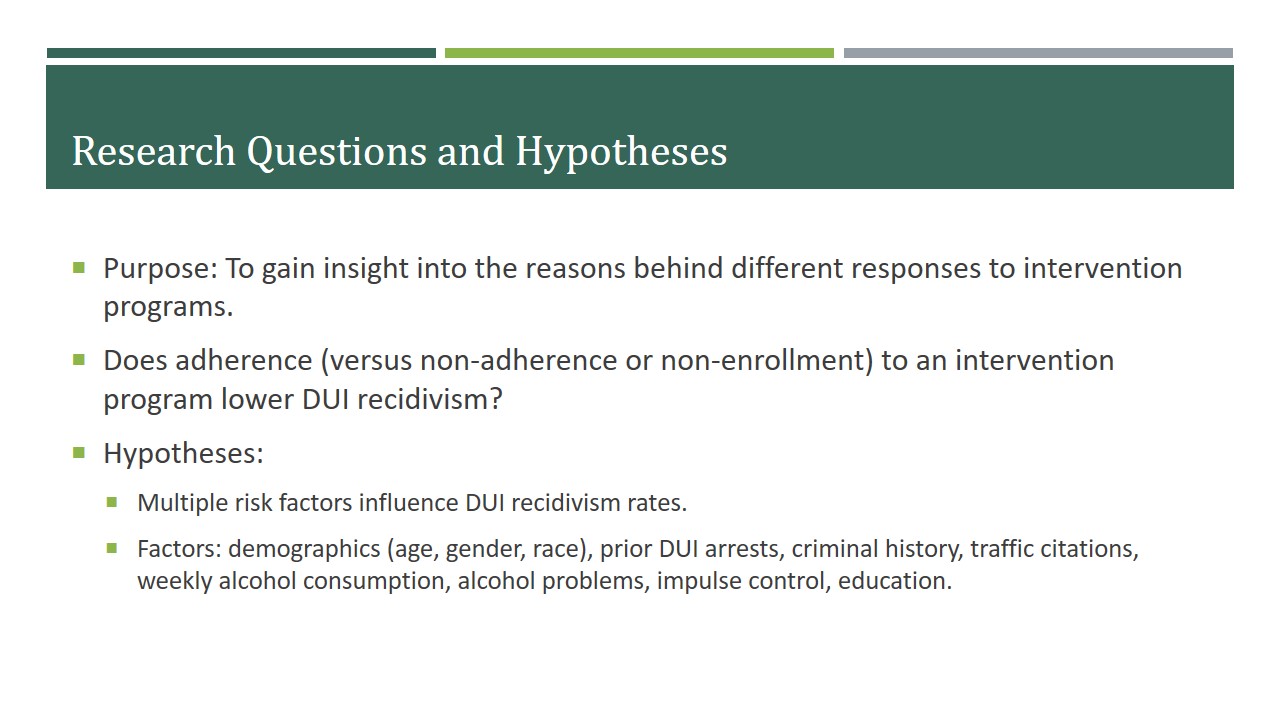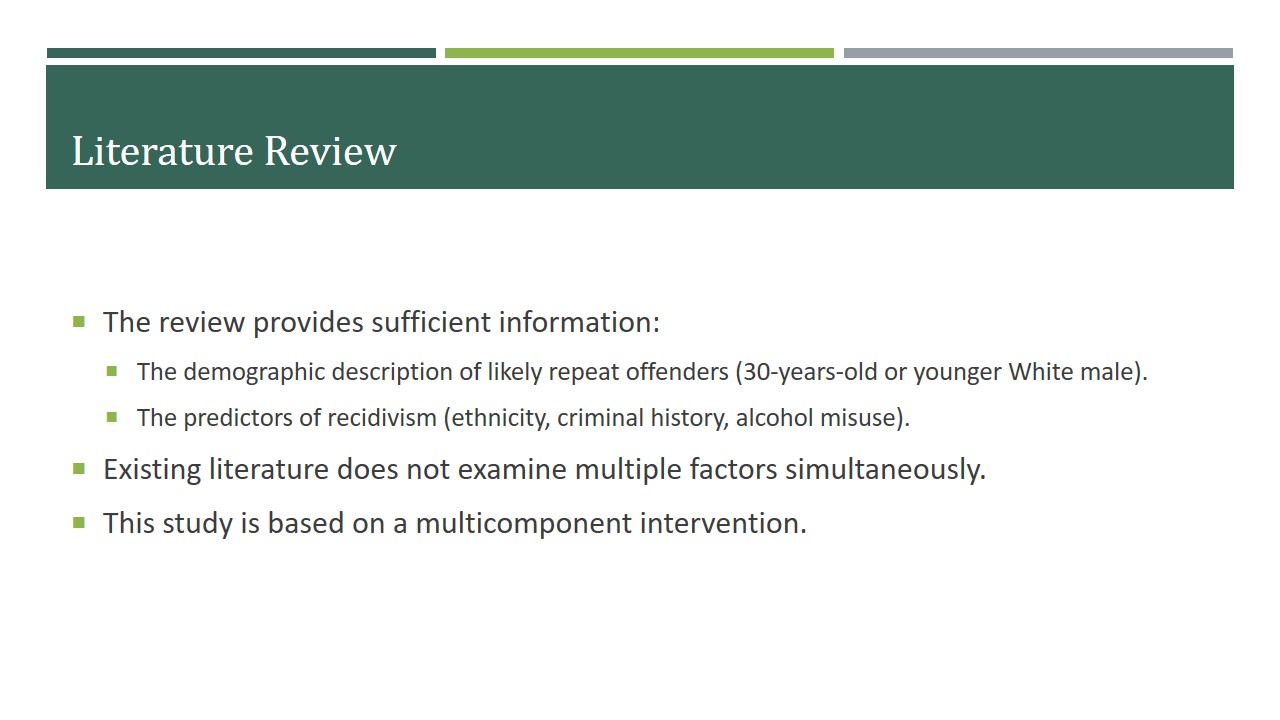Abstract
- The study investigates the link between intervention adherence and DUI recidivism.
- Issues:
- The lack of diversity in the sample;
- Limitations of using administrative data;
- Absence of written consent and opportunities for withdrawal.
- Implications:
- Substantial evidence in support of involved interventions;
- Cultural differences have to be considered in program design.
The presentation examines the quality of research considering the effect of intervention adherence on DUI recidivism. The research question posed by the authors is clear; it is based on the sufficient literature review that describes the current problems in DUI recidivism prevention. The study employs a quasi-experimental design and purposive sampling, which, while choosing suitable participants, fails to address the issue of minorities’ representation. The results of the Cox Regression Model demonstrate that multiple risk factors can predict recidivation, but adherence to intervention programs lowers repeat offenses significantly. Overall, the study presents a high quality of research, but some ethical issues require further consideration.

Research Questions and Hypotheses
- Purpose: To gain insight into the reasons behind different responses to intervention programs.
- Does adherence (versus non-adherence or non-enrollment) to an intervention program lower DUI recidivism?
- Hypotheses:
- Multiple risk factors influence DUI recidivism rates.
- Factors: demographics (age, gender, race), prior DUI arrests, criminal history, traffic citations, weekly alcohol consumption, alcohol problems, impulse control, education.
In their study, Robertson, Gardner, Walker, and Tatch (2016) review the impact of different factors on people’s rates of DUI (driving under the influence) recidivism. Specifically, they pose a research question about the effectiveness of adhering to a driving program in contrast to non-adherence and non-attendance. Furthermore, Robertson et al. (2016) hypothesize that different characteristics (age, gender, race, education level, and others) influence the recidivism rates. The purpose of this research is to analyze the connections between multiple risk factors, interventions, and recidivism.

Literature Review
- The review provides sufficient information:
- The demographic description of likely repeat offenders (30-years-old or younger White male).
- The predictors of recidivism (ethnicity, criminal history, alcohol misuse).
- Existing literature does not examine multiple factors simultaneously.
- This study is based on a multicomponent intervention.
The authors use the existing scholarship to construct their research. Robertson et al. (2016) show that the previous findings describe potential repeat DUI offenders as men younger than 30 who “completed 12 or fewer years of education and have low socioeconomic status” (p. 597). The literature review is comprehensive, examining the different approaches to researching this topic. The scholars aim to prove that their study is significant since older research does not analyze the factor of program adherence or the impact of several factors on recidivism rates.

Design and Sampling
- One-group quasi-experimental design.
- Non-probability, purposive sample.
- Participants: Individuals ordered to complete the MASEP (Mississippi Alcohol Safety Education Program) between 2008 and 2010.
- Gender: 80.2% male, 19.8% female.
- Race: 58.8% White, 38.7% African American/Black, 2.6% other.
- Program completion: 62.4% completed, 8.8% non-adherent, 28.8% non-enrolled (Robertson et al., 2016, p. 601).
The authors utilize a quasi-experimental design with purposive sampling since they need to review the impact of one intervention on people who were ordered to complete the program. They collect the necessary information through the program’s data and state administrative records. It is implied that the first DUI offense is followed by the court’s order to participate in the MASEP, but Robertson et al. (2016) note that some of the individuals had prior DUI offenses.

Measures: Intervention
- Mississippi Alcohol Safety Education Program (MASEP).
- 4 weekly 3-hour sessions.
- Homework with additional information.
- Self-monitoring for substance use, triggers, and patterns.
- DUI avoidance plan presentation to peers.
The intervention is the MASEP, a court-mandated program for first-time DUI offenders issued in the state of Mississippi. It includes such steps as the education about health effects and driving impairments of alcohol and other drugs, Motivational Enhancement Therapy (MET), group interaction to encourage discussion, individualized feedback about drug use problems and future risks, and problem-solving training (Robertson et al., 2016). Full adherence implies that a participant was present on all sessions and completed homework assignments as intended.

Measures: Variables
- Independent: program completion.
- Control:
- Demographics (race, gender, age);
- Prior DUI arrests, criminal history, traffic citations;
- Recent alcohol and drug use (prescription pain medications, marijuana, mixing alcohol and drugs);
- Weekly alcohol consumption;
- Alcohol problem severity (AUDIT, Alcohol Use Disorders Identification Test);
- Impulse control (Drinker Inventory of Consequences and Research Institute on Addictions Self-Inventory), Cronbach alpha = .62 (Robertson et al., 2016).
- Dependent: DUI recidivism (DUI-related arrest within 3 years of the MASEP referral/enrollment).
Since Robertson et al. (2016) proposed an analysis of multiple recidivism factors, the study has many variables. The main connection is drawn between the completion of the intervention and the rate of recidivism. Nonetheless, the authors also account for various aspects of people’s status, demographics, and history of drug use and offenses. The dependent variable is based on administrative records of arrests.

Data Analysis
- Strategy: a multivariate Cox Regression Model.
- Hazard ratios are examined as odds ratios.
- Examines various predictors of recidivism within 3 years.
Cox regression is a method that examines the time until the event (in this case, a repeat DUI offense). This model allows one to use multiple predictors, such as the control variables that were mentioned previously. It also is effective for handling censored cases, when recidivation does not happen in the established period of time. Thus, Cox regression can be used in this research to analyze participants who were and were not arrested on repeat DUI charges. The use of this model directly refers to the research question since it investigates the effects of completion on recidivism. It also helps to confirm the hypotheses that multiple factors impact recidivation rates by including other variables.

Data Analysis (Results)
The results demonstrate that the participants who completed the MASEP had a lower recidivism rate (23.1%) than non-adherent offenders (28.3%) and non-enrolled individuals (29.2%) (Robertson et al., 2016, p. 601). The difference is statistically significant between the first and the two other segments (χ 2 = 86.180, p < .001). In relation to the demographics, the rates vary significantly in all groups. Among the people who completed the intervention, females (17.3%) were less likely to recidivate than males (24.6%; χ 2 = 62.115, p < .001). The recidivation rates of African Americans (both men and women, 25.3%) were higher than those of White participants (22.0%; χ 2 = 20.757, p < .001). Offenders who were 33 and younger (24.4%) were more likely to recidivate than their older counterparts (21.8%; χ 2 = 12.588, p < .001). As for the predictors of recidivism, non-adherence, male gender, African American race, less education, young age, high AUDIT scores, low impulse control scores, a non-DUI criminal record, and previous traffic citations were found to be significant (Robertson et al., 2016).

Ethical Considerations
- Approved by Mississippi State University’s Institutional Review Board (IRB).
- Implied consent.
- Use of IDs and social security numbers lowers anonymity.
- Focus on White and African American males.
The study was approved by the IRB, and the authors guaranteed the participants full anonymity. However, Robertson et al. (2016) did not ask for written consent, stating that the agreement to participate was implied by the completion of the assessment. This lack of clarity and inability of individuals to withdraw the information raises some ethical issues for the study. Moreover, the sample’s purposive aspect highlights the need to represent minority populations adequately to avoid incorrect results. The demographics of the sample show that the research appraised mostly White and Black participants, while individuals of other races comprised less than 10% Similarly, less than 20% of all offenders were women, which also undermines the findings about their response to the intervention.

Consistency with Social Work Values and Priorities
- Relevant Values:
- Service;
- Social justice;
- Dignity and worth of the person;
- Importance of Human Relationships.
The examined study addresses the social problem of DUI offenses, providing insight into the effectiveness of intervention programs. Thus, its results can help people to improve the existing initiatives and lead to lower arrest numbers. Robertson et al. (2016) address the study’s finding that shows its lack of appeal for African American participants and people with less education. The program’s creators should reevaluate these factors to limit social inequality in access to knowledge. The authors’ comments about diversity show that they are mindful of people’s unique differences. The importance of human interaction can be seen in the program itself, which prioritizes group work, feedback, and peer support. Overall, the study’s consistency with the values of social work is limited by the sample.

Summary
- Research questions are clear.
- The literature review is sufficient.
- The sample lacks diversity.
- The analysis is transparent.
- Findings reveal new valuable information.
The study by Robertson et al. (2016) offers a new approach to analyzing potential recidivation among first DUI offenders. It is based on existing research, but it also provides some new data and shows that predictions should not rely on one factor. The sample does not represent some minorities sufficiently, which means that some of the findings may not be applied in many settings. Nonetheless, this study presents a model that can help intervention developers in creating programs that can appeal to and help people with different cultural and socioeconomic backgrounds. To sum up, the main weaknesses are the sample and some ethical issues related to anonymity and consent, while the chosen analysis model is a strength of the research.

Implications for the Research
- Intervention programs need to be understandable.
- Minorities’ cultural differences have to be acknowledged.
- Initiatives with multiple strategies may be successful.
- More research into the different risk factors is necessary.
The findings of this research indicate that the information presented during programs is challenging for some participants, depending on their education. The design of these interventions should change to appeal to more people. Adherence is tied to lower recidivation rates, thus stressing the importance of ensuring that people attend all sessions and complete all assignments. More studies should be conducted to see what particular activities encourage attendance. In particular, it is vital to find what is attractive to people with different experiences.

Reference
Robertson, A., Gardner, S., Walker, C. S., & Tatch, A. (2016). DUI recidivism by intervention adherence: A multiple risk factor approach. The American Journal of Drug and Alcohol Abuse, 42(5), 597-605.